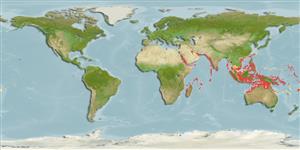>
Eupercaria/misc (Various families in series Eupercaria) >
Labridae (Wrasses)
Etymology: Paracheilinus: Greek, para = the side of + Greek, chaite = hair + Greek, odous = teeth (Ref. 45335).
More on authors: Randall & Harmelin-Vivien.
Environment: milieu / climate zone / depth range / distribution range
Ecología
marino asociado a arrecife; rango de profundidad 5 - 50 m (Ref. 90102), usually 5 - 40 m (Ref. 27115). Tropical; 25°C - 28°C (Ref. 27115)
Distribución
Países | Áreas FAO | Ecosistemas | Ocurrencias, apariciones | Point map | Introducciones | Faunafri
Indo-West Pacific: western Indian Ocean to Fiji. Questionable record from Indonesia (Ref. 8631).
Tamaño / Peso / Age
Maturity: Lm ? range ? - ? cm
Max length : 8.0 cm TL macho / no sexado; (Ref. 11441)
Short description
Claves de identificación | Morfología | Morfometría
Only the first dorsal soft ray prolonged in adults; penultimate dorsal soft ray of males 1.6-2.0 in HL; a single short dark stripe beneath pectoral fin (Ref. 41634).
Inhabits outer reef slopes, over rubble, algae, or coral (Ref. 9710). Occurs in small groups of mix sexes but females outnumber males greatly (Ref. 48636). Swim close to the bottom and females swim in small groups. Males swim around them and often hurry from one area to another where there are groups of females. Some juveniles are secretive and often single or small groups amongst the rubble (Ref. 48636).
Life cycle and mating behavior
Maturities | Reproducción | Spawnings | Egg(s) | Fecundities | Larva
Oviparous, distinct pairing during breeding (Ref. 205).
Randall, J.E. and R. Lubbock, 1981. Labrid fishes of the genus Paracheilinus, with descriptions of three new species from the Philippines. Jap. J. Ichthyol. 28(1):19-30. (Ref. 2139)
IUCN Red List Status (Ref. 130435)
Threat to humans
Harmless
Human uses
Pesquerías: comercial; Acuario: Comercial
Herramientas
Special reports
Download XML
Fuentes de Internet
Estimates based on models
Preferred temperature (Ref.
123201): 26.2 - 29.1, mean 28.2 °C (based on 1868 cells).
Phylogenetic diversity index (Ref.
82804): PD
50 = 0.5000 [Uniqueness, from 0.5 = low to 2.0 = high].
Bayesian length-weight: a=0.00955 (0.00456 - 0.02002), b=3.06 (2.89 - 3.23), in cm total length, based on LWR estimates for this (Sub)family-body shape (Ref.
93245).
Nivel trófico (Ref.
69278): 3.4 ±0.45 se; based on food items.
Resiliencia (Ref.
120179): Alto, población duplicada en un tiempo mínimo inferior a 15 meses (Preliminary K or Fecundity.).
Fishing Vulnerability (Ref.
59153): Low vulnerability (10 of 100).
Nutrients (Ref.
124155): Calcium = 138 [79, 283] mg/100g; Iron = 1.06 [0.60, 2.06] mg/100g; Protein = 18.1 [15.2, 20.3] %; Omega3 = 0.178 [0.099, 0.313] g/100g; Selenium = 24.9 [13.0, 50.2] μg/100g; VitaminA = 242 [72, 905] μg/100g; Zinc = 2.04 [1.31, 3.24] mg/100g (wet weight);
